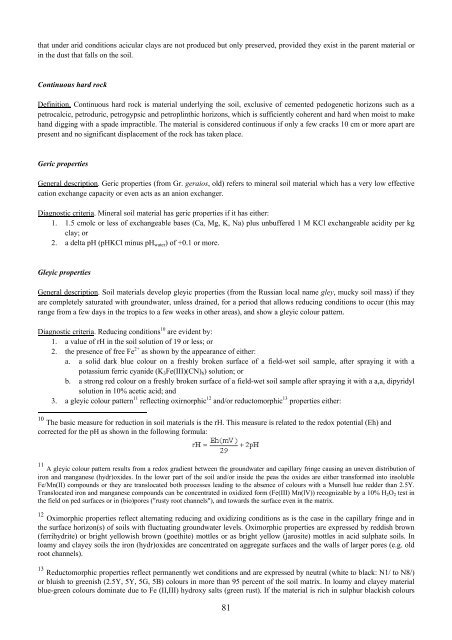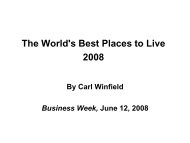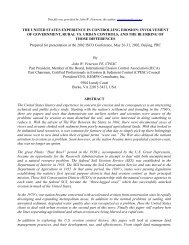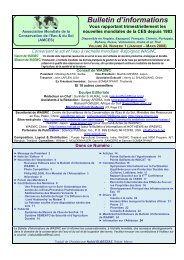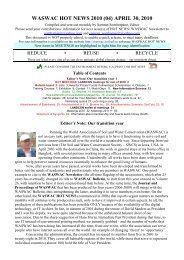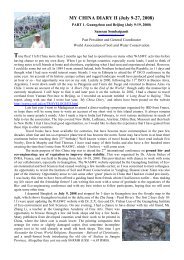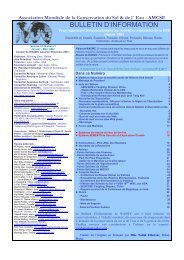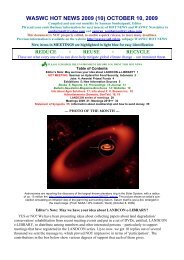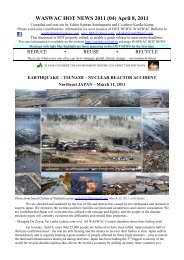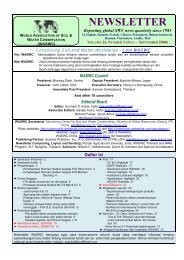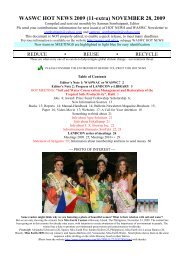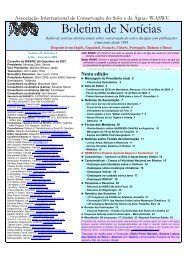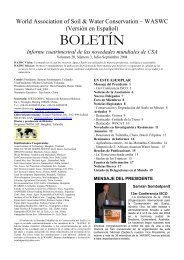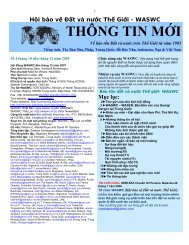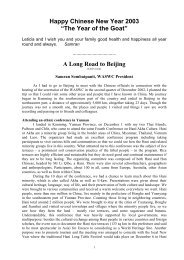Soils of the European Union - European Soil Portal - Europa
Soils of the European Union - European Soil Portal - Europa
Soils of the European Union - European Soil Portal - Europa
Create successful ePaper yourself
Turn your PDF publications into a flip-book with our unique Google optimized e-Paper software.
that under arid conditions acicular clays are not produced but only preserved, provided <strong>the</strong>y exist in <strong>the</strong> parent material orin <strong>the</strong> dust that falls on <strong>the</strong> soil.Continuous hard rockDefinition. Continuous hard rock is material underlying <strong>the</strong> soil, exclusive <strong>of</strong> cemented pedogenetic horizons such as apetrocalcic, petroduric, petrogypsic and petroplinthic horizons, which is sufficiently coherent and hard when moist to makehand digging with a spade impractible. The material is considered continuous if only a few cracks 10 cm or more apart arepresent and no significant displacement <strong>of</strong> <strong>the</strong> rock has taken place.Geric propertiesGeneral description. Geric properties (from Gr. geraios, old) refers to mineral soil material which has a very low effectivecation exchange capacity or even acts as an anion exchanger.Diagnostic criteria. Mineral soil material has geric properties if it has ei<strong>the</strong>r:1. 1.5 cmolc or less <strong>of</strong> exchangeable bases (Ca, Mg, K, Na) plus unbuffered 1 M KCl exchangeable acidity per kgclay; or2. a delta pH (pHKCl minus pH water ) <strong>of</strong> +0.1 or more.Gleyic propertiesGeneral description. <strong>Soil</strong> materials develop gleyic properties (from <strong>the</strong> Russian local name gley, mucky soil mass) if <strong>the</strong>yare completely saturated with groundwater, unless drained, for a period that allows reducing conditions to occur (this mayrange from a few days in <strong>the</strong> tropics to a few weeks in o<strong>the</strong>r areas), and show a gleyic colour pattern.Diagnostic criteria. Reducing conditions 10 are evident by:1. a value <strong>of</strong> rH in <strong>the</strong> soil solution <strong>of</strong> 19 or less; or2. <strong>the</strong> presence <strong>of</strong> free Fe 2+ as shown by <strong>the</strong> appearance <strong>of</strong> ei<strong>the</strong>r:a. a solid dark blue colour on a freshly broken surface <strong>of</strong> a field-wet soil sample, after spraying it with apotassium ferric cyanide (K 3 Fe(III)(CN) 6 ) solution; orb. a strong red colour on a freshly broken surface <strong>of</strong> a field-wet soil sample after spraying it with a a,a, dipyridylsolution in 10% acetic acid; and3. a gleyic colour pattern 11 reflecting oxirnorphic 12 and/or reductomorphic 13 properties ei<strong>the</strong>r:10 The basic measure for reduction in soil materials is <strong>the</strong> rH. This measure is related to <strong>the</strong> redox potential (Eh) andcorrected for <strong>the</strong> pH as shown in <strong>the</strong> following formula:11 A gleyic colour pattern results from a redox gradient between <strong>the</strong> groundwater and capillary fringe causing an uneven distribution <strong>of</strong>iron and manganese (hydr)oxides. In <strong>the</strong> lower part <strong>of</strong> <strong>the</strong> soil and/or inside <strong>the</strong> peas <strong>the</strong> oxides are ei<strong>the</strong>r transformed into insolubleFe/Mn(II) compounds or <strong>the</strong>y are translocated both processes leading to <strong>the</strong> absence <strong>of</strong> colours with a Munsell hue redder than 2.5Y.Translocated iron and manganese compounds can be concentrated in oxidized form (Fe(III) Mn(lV)) recognizable by a 10% H 2 O 2 test in<strong>the</strong> field on ped surfaces or in (bio)pores ("rusty root channels"), and towards <strong>the</strong> surface even in <strong>the</strong> matrix.12 Oximorphic properties reflect alternating reducing and oxidizing conditions as is <strong>the</strong> case in <strong>the</strong> capillary fringe and in<strong>the</strong> surface horizon(s) <strong>of</strong> soils with fluctuating groundwater levels. Oximorphic properties are expressed by reddish brown(ferrihydrite) or bright yellowish brown (goethite) mottles or as bright yellow (jarosite) mottles in acid sulphate soils. Inloamy and clayey soils <strong>the</strong> iron (hydr)oxides are concentrated on aggregate surfaces and <strong>the</strong> walls <strong>of</strong> larger pores (e.g. oldroot channels).13 Reductomorphic properties reflect permanently wet conditions and are expressed by neutral (white to black: N1/ to N8/)or bluish to greenish (2.5Y, 5Y, 5G, 5B) colours in more than 95 percent <strong>of</strong> <strong>the</strong> soil matrix. In loamy and clayey materialblue-green colours dominate due to Fe (II,III) hydroxy salts (green rust). If <strong>the</strong> material is rich in sulphur blackish colours81


